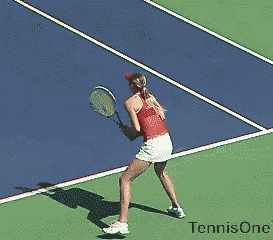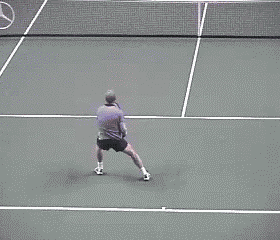|
TennisOne Lessons Developing Your Groundstrokes All things are not equal Dave Kensler - Peter Burwash International (PBI) Often when the issue of groundstrokes is mentioned, the phrase, “A tennis player should develop the forehand and backhand equally,” or something similar will be emphasized.
This, to me, is too general an approach. Why? Because it is important to recognize the differences in these strokes; grips are often different, the physical strength on one side of the body versus the other side is not the same, and the swing motion can vary. They really are two different shots. The players on the professional tour can often provide us with valuable “markers.” While we may not be able to hit the ball the way they can (Otherwise we would be on the tour ourselves!), we can learn a lot from their mechanics and statistics. For example, on the issue of winners at the pro level, in most matches perhaps 10-15% of the winners hit are with the backhand groundstroke. The big shots being the serve, forehand groundstroke, and volley. So on statistical basis alone, if we use the pro tour as a gauge to our own game, there is a need to develop the forehand differently than the backhand. Even with the growth in popularity over the years of the two-handed backhand groundstroke, at almost every level you need a strong forehand to force errors and hit some winners. In my opinion, if the strength of your tennis game is your backhand groundstroke, then I think you are going to have difficulty winning matches because that means your backhand is a bigger weapon than your serve, forehand, return of serve and volley! Over the years, I've often asked my students, “Who do you play against who stands three feet behind the baseline and blasts backhand winners all over the court?” The answer is always, “Nobody.” I tell them one reason is because it doesn’t happen at the pro level either! If the pros aren’t doing it, you can be fairly certain the rest of us mortals who play this sport aren’t doing it either. My belief is the forehand and backhand ground strokes do need to be developed equally, but differently! Following are three tips each on how to develop your ground strokes equally and then three tips on what to do differently: Developmental Equalities on the Forehand and Backhand Groundstrokes A Defensive Foundation. This is one of the most misunderstood aspects of the pro game. All the top tour players have a strong defensive foundation with their groundstrokes. “Defensive” doesn’t mean “pushing” or hitting softly. Rather it means being able to keep the ball in play consistently regardless of how hard the ball is hit. Whether it takes five or twenty shots to win a point, Andre Agassi can do both. That is what it means to have a strong defensive foundation. Use of the Non-Hitting Hand. Maximize control of the racquet head with your non-hitting hand will result in better control of your shots. It will also allow you to correct your mistakes (see Dave's article, Use Your Opposite Hand to Improve Your Tennis Game).
Hit to Different Areas of the Court. Once you can keep the ball in play consistently, you have to be able to do something with it. Depth, spin, and power are all important “features” which can be useful. However, whether you hit with topspin or underspin or hit a relatively flat ball, you must be able to add direction to your shots so you can hit the ball to different areas of the court. Placing the ball in different areas of the court will allow you to get your opponent moving and take control of the point. At the very least, you must be able to hit to both your opponent's forehand and backhand. Once tennis players have to move, the number of mistakes almost always goes up. Would you rather hit a shot standing still or on the run? Developmental Differences on the Forehand and Backhand Groundstrokes Make Your Forehand a Weapon Before the Backhand. This goes back to my earlier point about the percentage of winners hit at the tour level with the backhand ground stroke versus other shots in tennis. What exactly does making your forehand a “weapon” mean? I feel you should be able to do two things:
Use the Backhand to Set Up the Forehand. This is similar to what happens in many other sports i.e. A football team establishes the running game to set up the passing game. A boxer uses the jab to set up the uppercut punch.
In my own game, I am much more consistent with my backhand (Defensive foundation) because I don’t take as many chances with it as I do on my forehand. I try to use hit my backhand in a way to give me the opportunity to do something more damaging with my forehand. As one example, I might hit a low, underspin backhand so my opponent is forced to hit the ball up so I can then move in and be more aggressive with a forehand. You don’t see very many tour players hitting forehands to position themselves to hit a “booming backhand.” It is the opposite. Develop an Inside Out Forehand. While he was not the first tour player to master this shot, Jim Courier certainly brought the inside out forehand more into the thinking of tennis players at all levels (see Dave Smith's article, A Tale of Two Forehands). Today, you will often see a pro player moving almost into the doubles alley to hit a forehand rather than “accept” the ball on their backhand side. This is related to the issue of direction and being able to hit to different areas of the court. If you can hit the side-T with your forehand instead of what normally might be a backhand crosscourt shot, then you have added one more forehand weapon option to your game! I am not talking about moving over to hit a forehand because you lack confidence in your backhand but rather purposely trying to position yourself for the inside out forehand so as to hit a winner or force a weak reply from your opponent.
Again, using the tour players as an example, how often do you see them hitting an inside out backhand compared to an inside out forehand? Practice Tip While there is nothing wrong or limiting in doing so, rather than practice your ground strokes equally, instead work on “opposites.” As an example using a ball machine, practicing equally would be hitting crosscourt on both shots. Practicing opposite would be to hit the backhand with underspin and the forehand with topspin. Or practice with the goal of keeping every backhand in play while going for a winner with your forehand. Developing your ground strokes equally but differently will make you a better tennis player! Your comments are welcome. Let us know what you think about Dave Kensler's article by emailing us here at TennisOne.
Dave Kensler has been teaching tennis for 23 years with Peter Burwash International (PBI). PBI contracts with resorts, hotels and clubs all over the world to direct tennis programs.The company presently has professionals working at 62 facilities in North America, Europe, Asia, Middle East, Caribbean, Pacific and Indian Ocean. During its 30 years in business, PBI tennis professionals have taught tennis in over 135 countries.For more information visit: www.pbitennis.com. |


